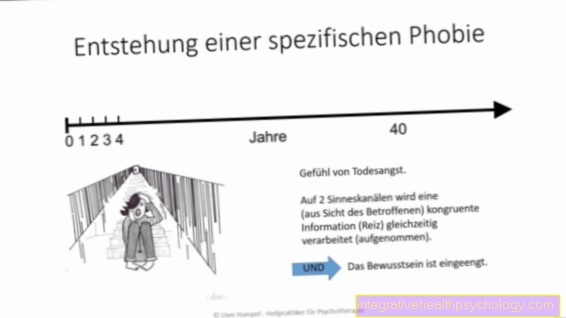Exercise after giving birth
introduction
If women who are physically active become pregnant, the question arises after the birth at the latest: When can I do sports again after giving birth? Women who have not done sport regularly before are also considering starting sport after giving birth to get their bodies back in shape. The birth of a child demands a great deal of effort from the woman's body. Many muscles are heavily used and the human skeleton, ligaments and tendons are also stressed beyond normal levels.
After a pregnancy, in addition to a light exercise program for the circulatory system, it is also advisable to perform postnatal exercises to stabilize the pelvic floor again. Other advantages of regular exercise after pregnancy are the prevention of symptoms such as incontinence, back pain, uterine sagging, abdominal discomfort and sexual aversion. If you are unsure about the duration and intensity of the exercise, you should not hesitate to contact your midwife or gynecologist.

When can I do sports again after giving birth?
It is recommended that you take a break from exercise of around six weeks after pregnancy. This is the period the body needs to recover from the stresses of pregnancy and childbirth. You can then carefully begin a light exercise program. First of all, it is advisable to start with light postnatal exercises. This strengthens the pelvic floor and the lower back muscles, which means that the core of the body gains more stability and back pain does not arise in the first place. The postnatal gymnastics phase is very important for general physical well-being after the birth and lasts up to ten weeks. Gradually more and more complex exercises, up to full-body exercises, can be incorporated.
Read more on this topic: Postnatal gymnastics, pelvic floor training after pregnancy
After the phase of regression and strengthening of the core, you can return to "normal" training. The principle should apply here that only what feels good to the body is good. The loads and volume of the training should be increased slowly and sufficient rest breaks are essential. In general, you should give the body enough time after the birth and start slowly with the right exercises. Wrong ambition and wrong exercises can seriously disrupt the recovery and regression process.
Regression after birth
After giving birth, the body is drained. In particular, the physical structures directly affected by the birth have been severely affected. In such a case, postnatal gymnastics can help quickly and specifically. The regression takes at least two months and the goal is to strengthen the core of the body and to train the pelvic floor and the other affected muscle groups that have been weakened by childbirth. The lower back was heavily stressed by the additional weight of the child and the muscles have to be rebuilt after the birth. The goal is to prevent back pain and not to provoke long-term problems in the lower back. The targeted pelvic floor training has a positive effect on several factors.
Read more on this topic: Training the pelvic floor after giving birth
By building muscle, a possible incontinence, a lowering of the uterus and abdominal pain are avoided. Postnatal exercise can also prevent sexual disinclination. It is therefore worthwhile to perform a regression not only for aesthetic reasons, but also for health reasons. The exercises should be done daily, but in short units. Ten minutes every day is enough to start with.
Lose weight while breastfeeding? Find out more about this here.
Cycling after giving birth
Exercising after childbirth has become more and more important for many women and the question of which sports you can take up again after giving birth is inevitable. The To go biking is generally considered to be very gentle sport and generally puts less strain on the circulatory system than other sports. After the birth, you should definitely wait for the first six weeks, as the mother-child bond is of great importance during this time. Then a ten-week postgraduate course occur. In these times women can do it again with the Start cycling. However it is importantthat all birth wounds healed completely beforehand are. This is especially in the case of a ruptured perineum necessary, as otherwise complications can arise from cycling. Easy bike tours are no longer a problem with completely healed wounds and you can do it with the light cardio training to be started when the doctor and midwife give their "OK". At the beginning you can possibly pad the saddle a little to avoid uncomfortable sitting positions and thus slowly increase the load.
Jogging after giving birth
In addition to cycling, other alternative endurance sports can already be started during postnatal gymnastics. These include light sports such as Nordic walking, walking and aqua jogging. The loads should be increased slowly within ten weeks. Afterwards, after consulting the doctor, you can slowly start running again. Every woman should pay attention to her own body and take a break if there are any unusual signs. A time frame that can be used as a guideline is as follows: After a few weeks, the athletic performance should have leveled off at around a third of the mileage before delivery. This time recommendation ensures that the training is not increased too quickly and too much, and that the build-up of endurance is accordingly gentle and slow. These recommendations apply to women who have given birth vaginally as well as women who have given birth by caesarean section.
Read more on the subject at: Jogging after giving birth
Training on the cross trainer after giving birth
Just like the other sports, it should Training with the cross trainer no earlier than six weeks after the birth to be started. The postnatal gymnastics should definitely be done. You can also start with a light workout on the cross trainer. Endurance sport on the cross trainer is gentler on the body than jogging, for example, as there are fewer vibrations on the body and the areas stressed by the birth. Training with the cross trainer is therefore well suited to slowly strengthening the body and making it fit again after delivery. Care should be taken that the Start training at a low level with low stress. 10 to 15 minutes with a maximum pulse of 110 beats per minute can be sufficient for this. Two days later, depending on your physical condition, you can train five minutes longer at the same intensity. In this way, in combination with sufficient rest breaks, training can be resumed in small steps. If during or after training Pain should occur definitely took a break and for safety a Clarification with the family doctor occur.
Are there differences between exercising after a natural birth and a caesarean section?
A caesarean section is an alternative way to give birth that women are increasingly choosing for non-health reasons. However, a caesarean section is a major surgical procedure that should not be underestimated. Exercise cannot simply be restarted after a caesarean section. There are a few important things that women should consider before they return to exercising.
After a caesarean section as well as after a natural birth, the doctor's “OK” should be obtained first. Especially after a caesarean section, the body must be given sufficient time to recover. It is essential to attend a recovery course, which supports the body in regeneration and strengthens and tightens the structures. If healing proceeds normally after a caesarean section, the course can be started after about twelve weeks without any risk. If you don't want to do without endurance training, you should talk to the doctor and midwife. For example, swimming is a good endurance exercise after a caesarean section.
After a natural delivery, the advice of a midwife and doctor should also be sought. Ideally, women can start again with light exercises such as back and abdominal exercises after four to six weeks. As with a caesarean section, the motto “start slowly and increase slowly” applies so that the body can adapt to the stress and is not overwhelmed. Sufficiently long and frequent breaks as well as a healthy and balanced diet help the body to regenerate optimally.
The following topic could also be of interest to you: What postnatal courses are there?
How can you train the pelvic floor?
In the regression course become many exercises to strengthen the pelvic floor shown and performed. In addition, the advice of the midwife and family doctor can be consulted. Women who want to start doing gentle exercises on their own should definitely clarify this with their midwife and / or doctor.
The following exercises train the pelvic floor in a gentle way:
In the "Dancer" is the starting position sitting on a chair. The back is kept straight and the entire upper body is inclined slightly forward, the head is in extension of the spine. Both feet are about hip-width apart and one of the two feet is turned slightly outwards. Now the pelvic floor should be actively tensed to activate the core of the body. The body is in a position in which it looks as if it is about to jump up.
At the "Butterfly" If you are lying on your back, the legs are drawn slightly towards the body so that the knees are approximately 90 degrees. The legs are spread slightly apart and the lower back is pressed to the floor. The stomach is also tensed and the soles of the feet are pressed together. After a few seconds, the tension is released and relaxed for a few seconds before the cycle begins again. The arms are stretched out next to the body on the floor.
How can you train the abs?
After giving birth, you can start with light abdominal muscle training alongside the postnatal training course. For this, however, the oblique abdominal muscles should always be trained first to prevent the straight abdominal muscles from diverging, a so-called rectus diastasis. Here, too, the following applies: In the event of pain or discomfort, the exercise should be ended immediately and a break should be taken.
Read more about this
- Abdominal muscle training after pregnancy
- Tight belly after pregnancy
As an exercise, for example, the lunge forward is recommended. The pelvic floor is lowered towards the floor, the upper body remains upright and the stomach is tense.
The so-called forearm support can be performed with the tips of your feet or your knees. The easier variant to start with is the knee-forearm support. Forearms and knees are on the floor and the upper body is horizontal to the floor in a stable, tense position. The head is an extension of the spine, looking towards the floor. The tension is held for a few seconds and slowly reduced.
Another exercise can be done lying on your back. The legs are straight and the arms are also straight next to the body on the floor. Now the woman tries to pull her belly button in towards the spine and keep this position briefly. The tension is then slowly released and the process is repeated a few times. This exercise activates the abdominal muscles in an effective way and is a gentle and gentle workout for the deeper abdominal muscles.
Read more on this topic: Abdominal muscle training after the removal of the uterus
What are the risks of exercising after giving birth?
Exercise should definitely be avoided within the first six weeks after the birth. A premature overexertion and stress on tissues damaged by childbirth disturbs not just that Healing process, rather can even lead to further injuries. For example, premature cycling can delay the healing of a tear in the perineum, or the wound can even rupture again.
Women who send their child by Caesarean section should have given birth especially careful be. The caesarean section is a big operationwhose effects and healing cannot be underestimated.
In any case, you should not start exercising until your doctor and midwife have given consent.





























